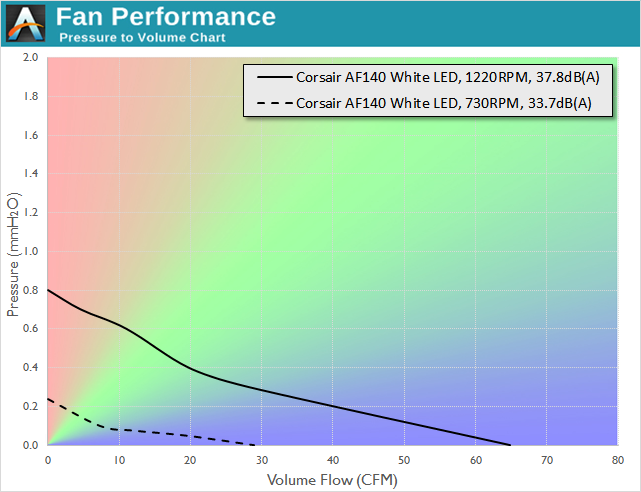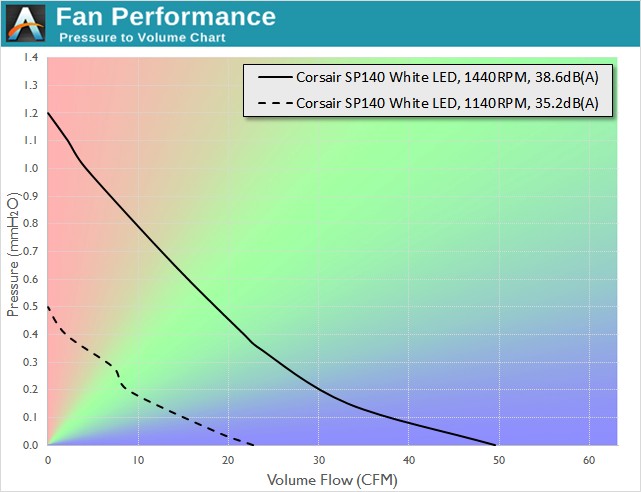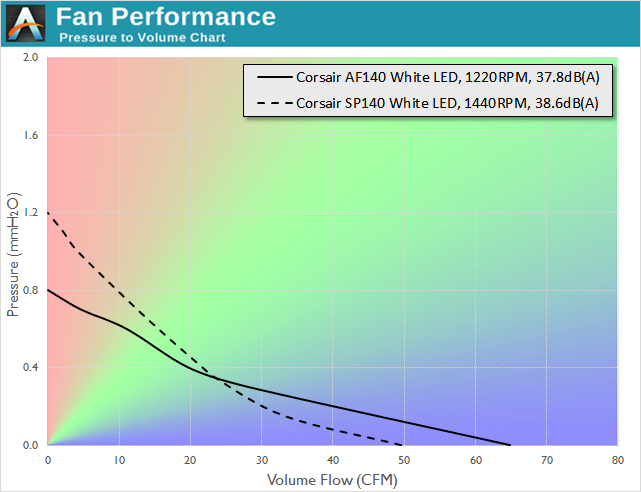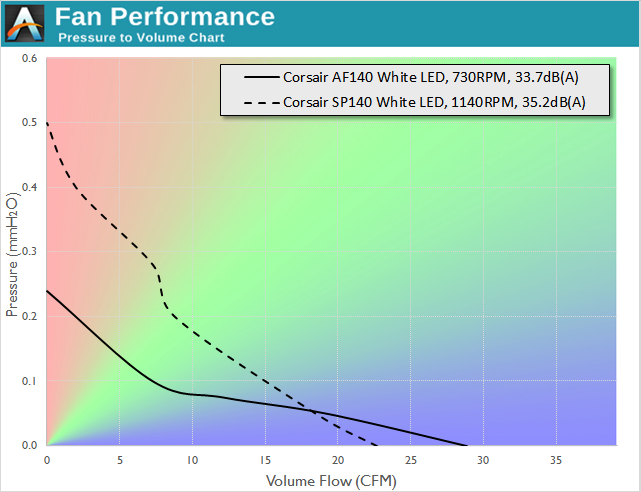The Corsair SP (Static Pressure), AF (High Airflow) 120/140mm Fan Review
by E. Fylladitakis on November 25, 2015 8:00 AM ESTCorsair's 140mm Performance
AF140 White LED Quiet Edition
As mentioned previously, the variation on Corsair's fans means that this one is our 140mm model in the 'High Airflow' (AF) category, focusing on low-impedance (case-fan style) scenarios. The LED versions are not built as sturdy as the non-LED models, and this one comes in with the 'Quiet Edition' moniker as well. Here are the results for the AF140 LED QE fan at high and low voltage settings:
As it can be seen from the above performance chart, the AF140 begins with very low static pressure readings but its airflow increases as the airflow impedance decreases. This increase is dramatic when the airflow impedance pressure drop is below 0.3 mmH2O while the fan is operating at its maximum speed.
SP140 White LED
The Static Pressure line of fans focuses more on the early end of the pressure/volume curve, aiming to get higher airflow at the same pressure while potentially sacrificing the total peak volume flow at zero pressure. Similar to the AF model above, this is a 140mm LED version but not in the quest range. Here are the 12V and 7V results:
As expected by its design and specifications, the SP140 has a good static pressure, nearly 50% better than that of the high airflow AF140. However, its pressure to flow curve declines faster and the SP140, even though it has a higher maximum speed than the AF140, cannot reach very high airflow values.
Comparing the AF140 LED QE and SP140 LED
If we do a direct comparison at the different voltage modes, we get the following for 12 volts:
Then this is for 7 volts (note the different scales on both axes):
Note that their rotational speeds are not the same at either voltage. Still, the slower AF140 can move greater volumes of air when the airflow impedance pressure drop is below 0.3 mmH2O. However, if the airflow impedance is high, the SP140 will clearly provide better performance.














92 Comments
View All Comments
Folterknecht - Wednesday, November 25, 2015 - link
Where was the author rude in his reply? Direct maybe, rude no!And as far as I can see the author is from europe - maybe both of them misunderstood each other completly when it comes to the term for resistance/ impedance. I get the feeling that american and european schools/universities might be using different terms and methods to describe the same phenomenon, that wouldn't be first time (X-Rays vs "Röntgenstrahlung").
And in general europeans are a little bit more direct and you re lucky that the author isnt from germany, we re often even more direct ;-)
No reason to get all upset here imo.
ImSpartacus - Wednesday, November 25, 2015 - link
As a reader for many many years, I'm admittedly a mega-fanboy of Anandtech and I've previously paraded them around as being nigh-perfect compared to other tech blogs in many areas - including their writers' attitudes with readers (which is often lacking as technical-minded people can often be).It really comes down to no longer being able to say almost-absurd comments like, "I've never seen a comment even remotely rude/insulting from an Anandtech writer" in good conscience. I like to think that if I'm going to act like a shameless fanboy around others, I have to be more than justified in doing so. I just can't do that anymore.
I fully realize that I probably put Anandtech on an unrealistically high pedestal. They are good, but the site is ultimately run by human beings and that's probably ok.
Beany2013 - Thursday, November 26, 2015 - link
If you want to get offended on someone else's behalf, Tumblr is thataway --->Although in all seriousness, I think you must have read that comment from an *entirely* different perspective to me; I thought it was two people familiar with the science discussing their different interpretations of terminology in a fairly chilled out way. I mean, if you think someone has got something completely wrong and are trying to explain it the way you understand it, it's hard to *not* come across as passive aggressive, but I'm not getting that vibe at all.
Kutark - Thursday, November 26, 2015 - link
I'll just leave this here for you, since clearly you ran out...http://www.amazon.com/Playtex-Tampons-Multipack-Un...
Oxford Guy - Thursday, November 26, 2015 - link
Save the sexism for 4chan where it can, at least, pose as wit.Phreedom1 - Sunday, December 6, 2015 - link
He wasn't rude in anyway. Man you are thin skinned. So many people these days getting upset over little or nothing.KAlmquist - Wednesday, November 25, 2015 - link
According to the Wikipedia article you link, "mechanical impedance" is the ratio of force to velocity in response to a harmonic force. It's analogous to electrical impedance. It follows that your use of the term "impedance" is incorrect for two reasons. First, you are measuring a constant airflow, not one that alternates directions. For "impedance" to be relevant, you would need a force that alternates directions, which would generate an alternating air flow. Second, air resistance is not proportional to air velocity, so there is no fixed ratio between the two. To talk about "impedance," you need a linear system.Your second link does show that your usage is not unique. But your usage doesn't seem to be correct.
jann5s - Thursday, November 26, 2015 - link
+1ninjaquick - Wednesday, November 25, 2015 - link
Impedance is the capacity or nature of impeding. Which is to say prevent motion or flow or activity.Saying it is limited to Electrical Engineering is like saying Tomatoes are limited to Ketchup.
wolfemane - Wednesday, November 25, 2015 - link
Why... What... What else would they be used for?????